If there’s one space in your house that sees plenty of spills, stains, and splotches, it’s the kitchen. From meal prep to dirty dishes, things can get messy quickly.
The kitchen is the “heart” of your home, so you want to keep it full of yummy smells and tastes. No one wants to cook on dirty stovetops or spend an hour hunting down one jar in the fridge!
But how to clean the kitchen and where do you start? We’ve broken down the chores into tasks you do daily, weekly, and monthly (or every few months).
Keep dust and dirt at bay by knowing what to clean, how to clean it, and how often!
With this step-by-step guide to kitchen cleaning, you’ll be ready to get down and dirty for a few hours — then reward yourself with the most delicious meal afterwards.
What Order to Clean | Before Cleaning | Everyday Cleaning | Weekly Cleaning | Deep Cleaning
How Often to Clean the Kitchen

Different items and surfaces in your kitchen will have different cleaning schedules.
Daily or routine cleaning includes washing dishes, wiping surfaces, tackling messes, and sweeping or vacuuming. Some appliances like stoves and ovens can be wiped after every use.
Weekly tasks include cleaning small appliances, washing the sink, and mopping or washing the floors.
Deep clean and declutter your kitchen once a month — or, for certain items, once every few months. This helps keep appliances in good working condition and ensures your kitchen is hygienic.
If you want help staying on top of all the chores, we’ll take care of it when you book a cleaning service with Maid2Match.
You can also refer to this kitchen cleaning checklist or save a copy for your convenience!
| HOW OFTEN | WHAT TO CLEAN |
|---|---|
| Daily cleaning | Wipe spills and messes |
| Wash dirty dishes | |
| Spot-clean appliances | |
| Minimise clutter on benchtops and shelves | |
| Wash the sink | |
| Wipe down kitchen surfaces | |
| Empty the rubbish bin | |
| Vacuum or sweep the floor | |
| Weekly cleaning | Wash the dishwasher filter |
| Clean small appliances | |
| Clean the sink and drain | |
| Clean the stovetop | |
| Clean the backsplash | |
| Wipe kitchen cabinets | |
| Disinfect rubbish bins | |
| Dust and wipe kitchen surfaces | |
| Mop or wash the floors | |
| Monthly or every few months | Clean the dishwasher and drain |
| Scrub floor tiles and grout | |
| Descale the kettle and filter | |
| Deep clean the fridge and freezer | |
| Declutter cabinets and drawers | |
| Deep clean the oven | |
| Clean the rangehood and filter | |
| Clean the exhaust fan |
In What Order Should I Clean the Kitchen?
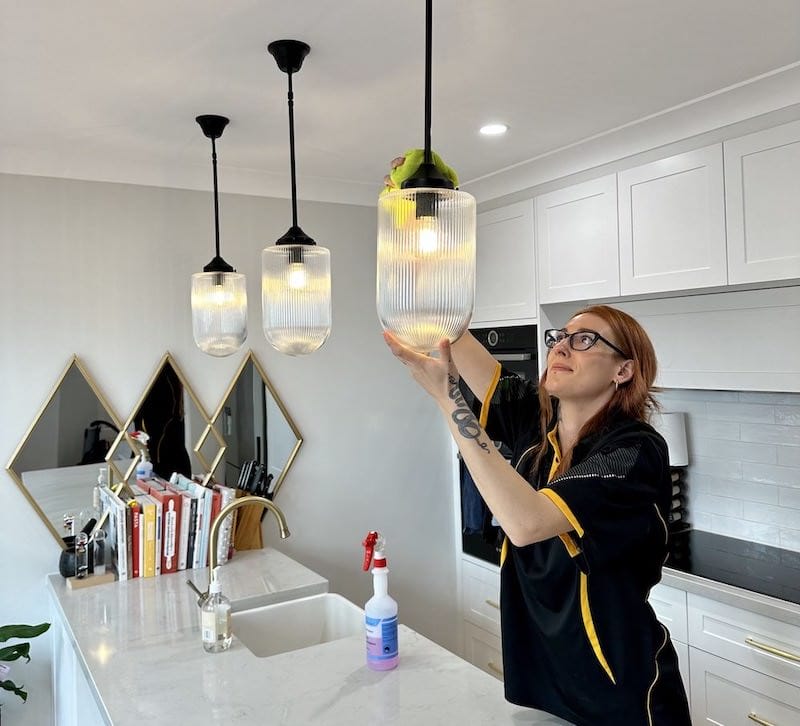
You want to clean your kitchen from top to bottom — starting from the uppermost spaces and then working your way downwards.
That way, any dust and debris that falls on the floor gets cleaned up last.
We’ve broken down the different spaces and surfaces in your kitchen into different layers for cleaning.
| Top spaces | Overhead light fixtures, tops of shelves and cabinets, floating cabinets, rangehood and filters, exhaust fan, etc. |
| Middle spaces | Cabinets, walls, sinks, stove, small appliances (e.g. microwave, kettle, coffee maker), benchtops, etc. |
| Appliances and accessories | Inside and outside of the fridge, freezer, oven (including accessories), dishwasher, drawers, rubbish bins, etc. |
| Bottom spaces | Underneath appliances or cabinets, mats, kitchen floors and grout |
Before Cleaning Your Kitchen: Tips and Things to Remember
While you’re prepping to get down and dirty, here are a few kitchen cleaning tips and things to keep in mind!
Don’t try to do everything all at once — especially if you plan to do some deep cleaning. Prioritise your tasks based on what you have time for and what’s most urgent.
If it helps, schedule 1–2 big tasks alongside several smaller ones. For example, you can plan to clean your oven alongside the stovetop and backsplash, then mop the floors afterwards.
Gather your cleaning materials first so you have them all on hand. This way, you’re not constantly pausing to find a sponge or a bottle of dish soap.
Look for multi-purpose cleaning products that work on different surfaces. It’s easier to carry around fewer products (and it saves you money, too).
If you’re conscious about using harsh chemicals, you can use Australian eco-friendly cleaning products that work great!
Also, make sure your chosen cleaner is compatible with the item you’re cleaning! For example, avoid using baking soda for aluminium or acidic cleaners for stone.
Tackle spills and messes ASAP — the longer a stain sits, the harder it is to remove. Wipe the mess with a cleaning rag or paper towels, and use an appropriate stain remover.
Wear protective gear while working! That includes rubber gloves and a face mask, especially if you’re using commercial cleaning products.
Additionally, open the windows and switch on any fans to ensure you’re in a well-ventilated space.
When cleaning appliances, switch them off and unplug them first. Wait for the appliance to cool down before you get to work.
Everyday Kitchen Cleaning Routine
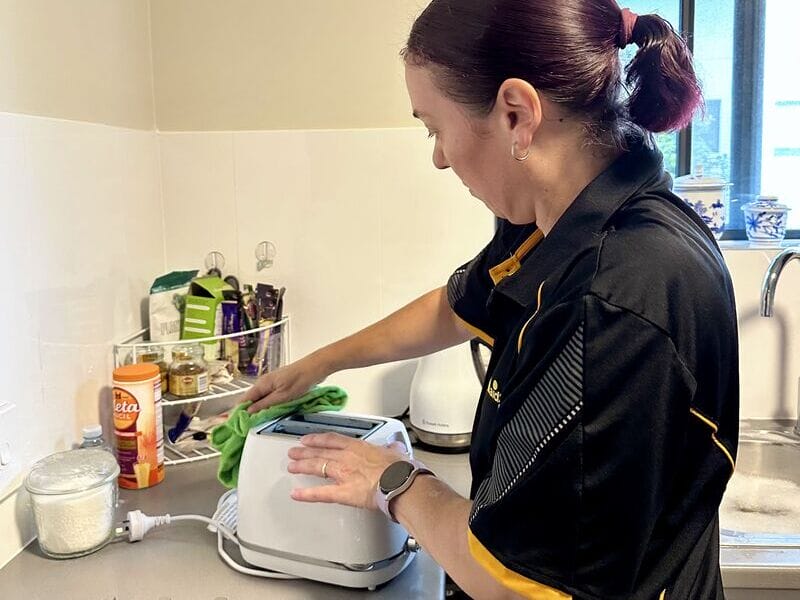
The goal of light or routine cleaning is to make it easier when you get to deep cleaning. These tasks help minimise the accumulation of dirt around the kitchen, saving you effort later on.
Try to get these tasks done daily, whether that’s spot-cleaning as you go or tidying up at the end of the day!
- Wipe food spills and messes ASAP
- Wash dirty dishes and wipe the table after every meal
- Spot-clean appliances like the toaster and coffee machine
- Minimise clutter on benchtops, shelves, and other open surfaces
- Wash the sink and faucet with hot, soapy water at the end of the day
- Wipe down the benchtop and other exposed surfaces
- Empty the rubbish bin to prevent pests, mould, and bacteria
- Vacuum or sweep at least once a day (or more often if you have pets)
Some appliances, like the oven or stovetop, can be lightly cleaned after every use. That lessens the build-up of grease and grime on the appliance surfaces.
For wiping and spot-cleaning, use an appropriate multipurpose cleaner and a soft microfibre cloth.
After handling raw meat — especially chicken — wash and disinfect your sink ASAP. Use 70% isopropyl alcohol for metal sinks or 3% hydrogen peroxide for granite or ceramic sinks.
If you need to get rid of unpleasant odours, heat up a pot of water with a little cinnamon or coffee. (As a bonus, this helps get rid of house flies that might be around.)
Weekly Kitchen Cleaning Routine
These are kitchen cleaning tasks you’ll need to do once a week! They’re not as intensive as deep cleaning, but they’re more thorough than the routine tasks you do daily.
Wash the dishwasher filter
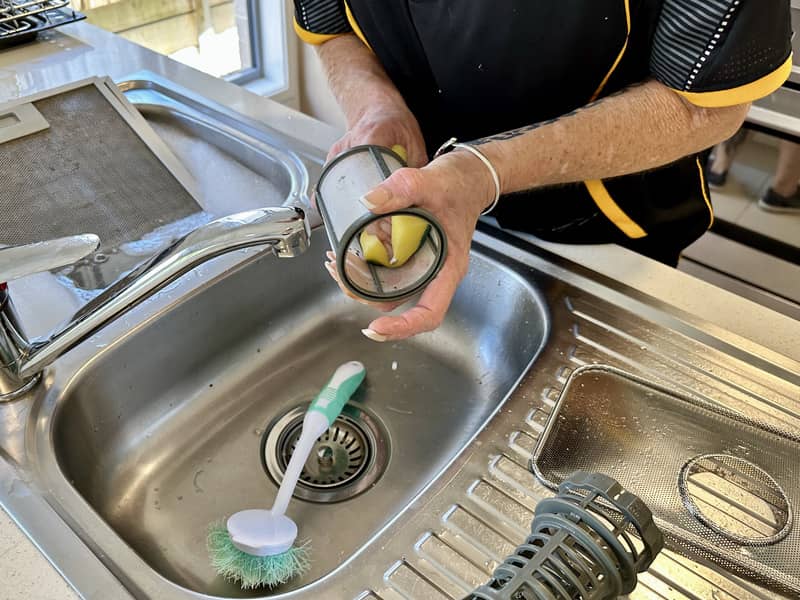
The filter is the unsung hero of your dishwasher. It traps food debris, grease, limescale, and detergent residue that’s washed off your dishes in every load.
That gunk builds up over time, so you need to clean the dishwasher filter regularly! Otherwise, you risk a clogged filter that prevents your dishwasher from draining — or worse, leads to mould or damage.
Soak the filter in some hot, soapy water for 10–15 minutes. Use a soft brush (like an old toothbrush) to scrub the filter clean, then rinse it off.
Let the filter dry before returning it to your dishwasher.
Clean small appliances
There are many little workhorses in your kitchen, from the microwave to the coffee maker. Once a week, do some quick routine cleaning to keep them in good condition.
Wash the air fryer basket and tray, or if the manufacturer allows it, place them in the dishwasher. Quickly wipe the interior with a damp cloth.
Clean the microwave by putting water and half a lemon in a microwave-safe container. Run the microwave for 2–3 minutes on high, then scrub the inside with a non-abrasive sponge.
Follow the manufacturer’s instructions for cleaning the coffee maker, especially if it needs backflushing. For a French press, give it a good wash with warm, soapy water.
Remove crumbs and food debris from the toaster, then wipe the interior. If the toaster has a crumb tray, remove it and quickly wash it in the sink.
For stainless steel appliances, you can clean the exteriors with white vinegar or a dedicated stainless cleaner.
To remove stuck-on food or stubborn stains, try a baking soda paste and scrub with a non-abrasive sponge. Wipe off the residue with a damp cloth afterwards.
Clean the sink and drain
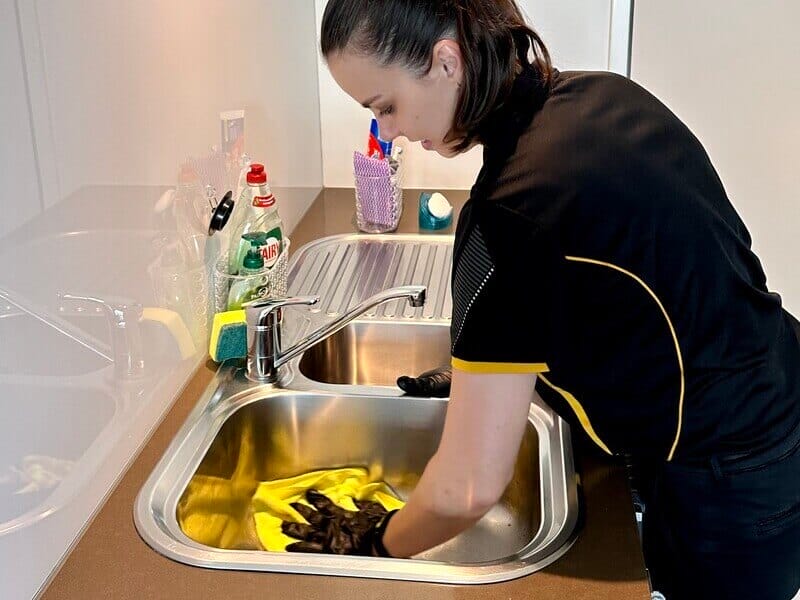
Once a week, thoroughly clean the sink and drain. Choose an appropriate cleaning solution for the type of sink!
- Aluminium: Soap and water
- Ceramic or porcelain: White vinegar and dish detergent
- Granite: pH-neutral soap or stone cleaner
- Stainless steel: Baking soda and soap
For the sink drain, boil equal parts vinegar and water in a kettle. Slowly pour the solution down the drain, pausing every once in a while to let it dissolve any build-up.
Thoroughly dry your sink afterwards so you don’t leave water spots.
Clean the stovetop
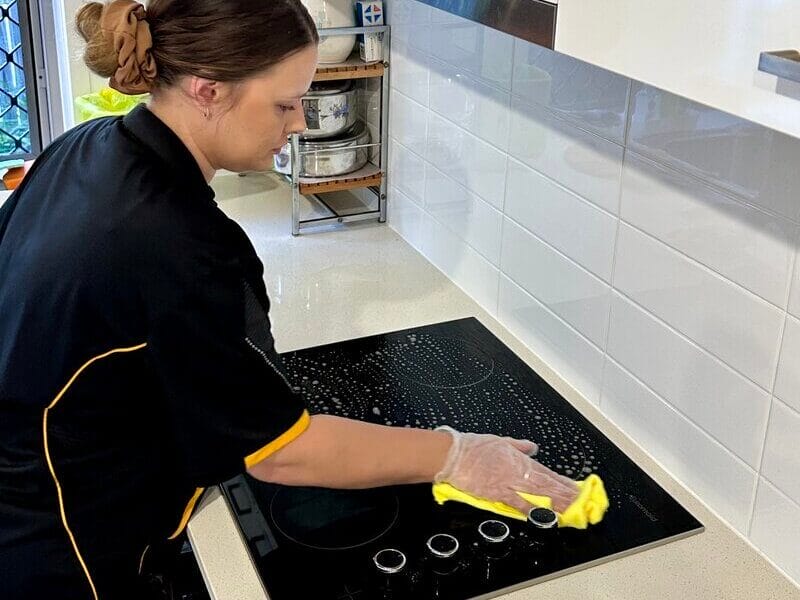
Keep your stovetop hygienic and safe by wiping it after every use (or at the end of the day). Then do more thorough maintenance once a week.
When cleaning the stovetop, choose a cleaner that’s appropriate for your stove type:
- Electric stovetop: Anti-grease dish soap and warm water
- Glass cooktop: Liquid dish soap and water
- Induction stovetop: Dish detergent and water
- Stainless steel stovetop: White vinegar and water
Always work with the stove shut off and cooled down. Unplug the stove or shut off the gas valve if possible.
Make sure to clean the stovetop grates, burner caps, and any knobs or buttons. Use a microfibre cloth to wipe any surfaces clean and a soft-bristled brush to scrub any stubborn dirt.
Clean the backsplash
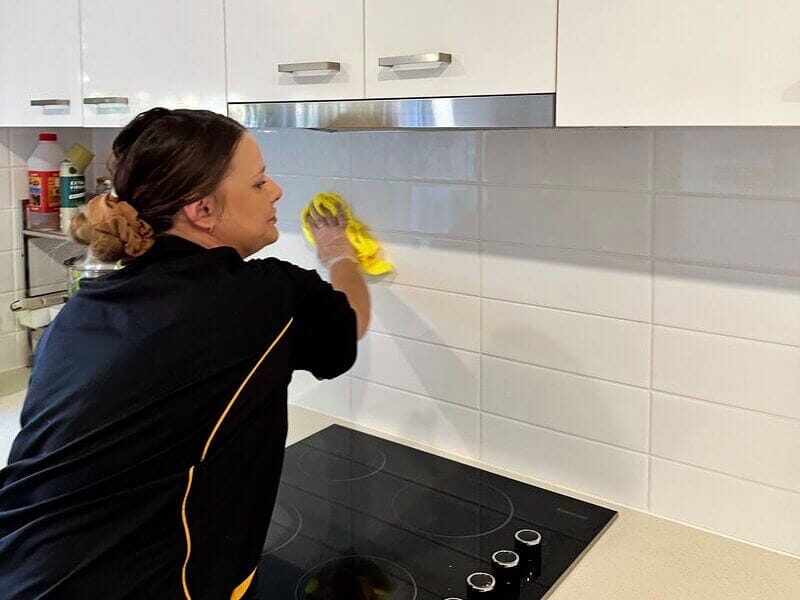
If your stovetop has a backsplash, you’ll need to clean that, too! The backsplash can see a lot of grease and grime, especially if you cook a lot.
For glass and tile backsplashes, your best bet is Dawn Powerwash. The product clings to vertical surfaces without running and does a good job of cutting through grease.
For stone backsplashes, opt for a safe stone cleaner such as Weiman Granite Cleaner or Oakwood 3-in-1 Stone Benchtop Cleaner. As a bonus, you can also use these products to clean stone benchtops.
Scrub the grout lines with an old toothbrush or soft-bristled brush, then wipe off any residue with a damp cloth.
Tackle kitchen cabinets
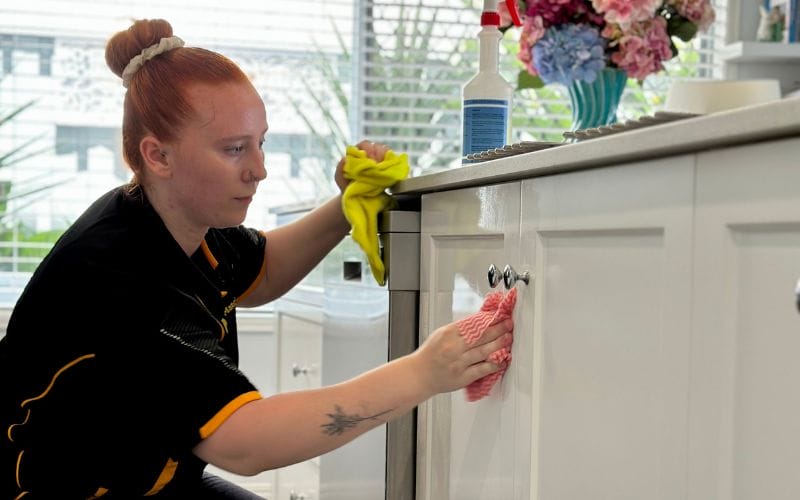
You don’t need to take out the contents and get into all the corners, but you should lightly clean your kitchen cabinets once a week!
The appropriate cleaner will depend on the cabinet material:
- High-gloss cabinets: White vinegar
- Laminate cabinets: Mild dish detergent and water
- Matte cabinets: Castile soap and hot water
- Metal cabinets: Dishwashing liquid or a dedicated stainless cleaner
- Painted cabinets: Mild soap and water
- Polyurethane cabinets: White vinegar and water
- Wood cabinets: Oil-based wood cleaner
Don’t forget to wipe the handles or knobs, and thoroughly dry the cabinets to prevent water stains.
For kitchen cabinets above the stove, use a good kitchen degreaser or a citrus-based cleaner.
Disinfect rubbish bins
Empty the rubbish bins regularly to prevent pests, mould, and bacteria. Then take some time each week to sanitise the bins!
Use your vacuum cleaner with a crevice attachment to suck out any loose debris from the bottom of the bins.
Afterwards, spray each bin — inside and out — with rubbing alcohol or commercial disinfectant. Wipe all the surfaces before putting in a new garbage bag.
Dust and wipe kitchen surfaces
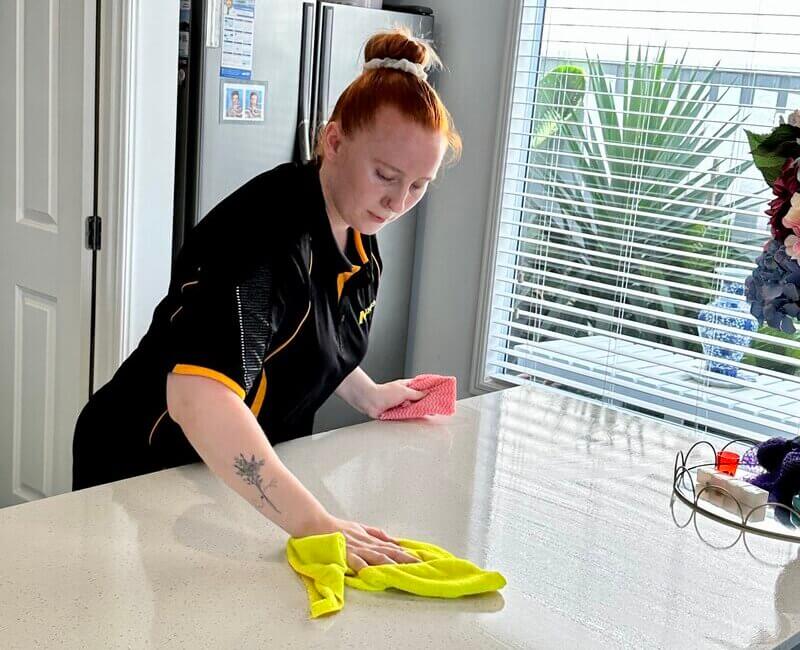
After cleaning all the appliances, it’s time to wipe any remaining kitchen surfaces, especially benchtops.
Again, start with the uppermost spaces and go from one side to the other, before working your way downwards.
Dust the light fixtures and the ceiling, especially the corners! Be sure to get the tops of any floating cabinets as well.
For benchtops, brush off dust and crumbs. Put any stray items (like those spices you used for lunch) back in their proper place.
Quickly clean the surfaces with a good multi-purpose product. Follow the package instructions and wipe off any residue afterwards with a soft cloth.
Wash or mop the kitchen floor
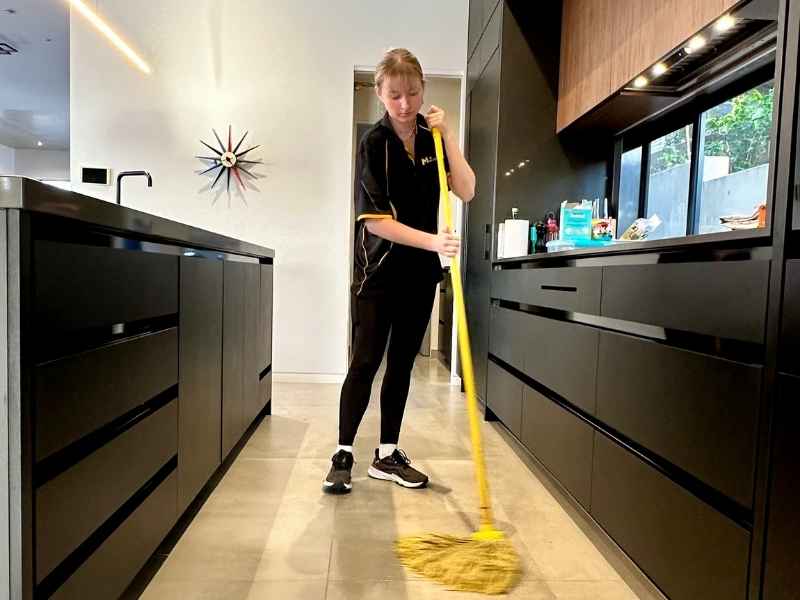
Last but not least, it’s time to clean the kitchen floor.
Sweep or vacuum the floor to remove loose dirt. Be sure to get underneath any large appliances and furniture, such as stools or the fridge.
Once that’s done, break out the mop and an appropriate cleaning solution!
For kitchen tile floors (such as ceramic tile), you can use:
- Diluted dish soap or detergent (1/4 cup per 3L of water)
- Vinegar and water (1 cup per 1L of water)
- Commercial tile cleaner
After you’ve mopped the floor, allow everything to air dry — and you’re done!
Deep Cleaning the Kitchen
These are the most intensive cleaning chores — ones that can take an hour or more.
Certain spaces and appliances in your kitchen need deep cleaning once a month (or once every few months) to keep everything hygienic and in good condition.
Remember, you don’t need to do all these chores at once! Pick the one that’s most urgent, and gather your cleaning supplies beforehand.
Clean the dishwasher

How often to clean: Once a month
Clean with: Dishwashing liquid or dishwasher cleaner
Much as we wish they were, dishwashers aren’t self-cleaning! Food debris, soap scum, and limescale accumulate over time, reducing the machine’s efficiency.
A dirty dishwasher might not clean the dishes properly, and could lead to unpleasant odours or even mould.
To deep clean the dishwasher inside and out, start by removing the spray arms and filter. Wash these separately with hot, soapy water.
Remove any visible debris from the dishwasher drain before flushing it with very hot water (about 82ºC). Then scrub the dishwasher tub clean with water, dish soap, and a non-abrasive sponge.
Wipe the exterior with a mix of equal parts vinegar and warm water.
You can also use a commercial dishwasher cleaner or check if your model has a self-cleaning cycle.
Scrub floor tiles and grout
How often to clean: Once a month
Clean with: Grout cleaner or peroxide
While you should mop kitchen tiles weekly, the grout lines need deep cleaning once a month! Dirty grout can make even the cleanest of tiles look less than pristine.
Look for a high-quality grout cleaner that’s safe for the type of kitchen tile.
Follow the package instructions and use a stiff-bristled brush or old toothbrush to scrub the grout clean.
If you prefer a DIY solution, mix equal parts hydrogen peroxide and water in a spray bottle, plus a few drops of dish detergent. Carefully spray onto the grout lines, then scrub with an old toothbrush.
For very dirty grout, you can sprinkle baking soda before spraying the peroxide solution.
Remember to re-seal the grout every 6 months!
Descale the kettle and filter
How often to clean: Every 2–3 months
Clean with: Lemon juice or citric acid
Glass and stainless steel kettles can accumulate mineral deposits and other dirt over time, even if you rinse them every day.
Thankfully, descaling and cleaning a kettle is pretty straightforward! For both stainless steel and glass kettles, you can use either lemon juice or citric acid.
Fill the kettle halfway with water, then add either half a lemon (sliced into wedges) or 1–2 tbsp of citric acid powder. Boil the solution, then take the kettle off the heat or switch it off.
Leave the solution to sit for around 20 minutes before scrubbing the kettle’s interior with a soft bottle brush. Rinse, then boil fresh water to remove any lingering taste.
You can descale a kettle filter by soaking it in some hot water and vinegar, then scrubbing it with dish soap.
Deep clean the fridge
How often to clean: Every 3–4 months
Clean with: Dish detergent and multi-purpose cleaner
As much as possible, keep an eye on the inside of your fridge. Spills and messes need to be cleaned up right away — otherwise, the food could spoil and lead to unpleasant odours.
Then, every few months, set aside an afternoon to thoroughly clean the fridge. Start by removing all the contents and checking for anything that’s expired, spoiled, or stale.
Take out shelves and drawers, which you can wash in soapy water.
Clean the interior of the fridge with a bleach-free multi-purpose cleaner and a soft cloth. Alternatively, look for a food-safe antibacterial or disinfectant spray.
Don’t forget to scrub the door gasket! Use the disinfectant or multi-purpose cleaner and an old toothbrush to scrub between the folds, then dry the gasket afterwards.
Do the same with your freezer. You can place the contents in an esky to prevent them from defrosting.
For a stainless steel fridge, clean the exterior with a dedicated stainless cleaner or diluted white vinegar.
Declutter cupboards and drawers
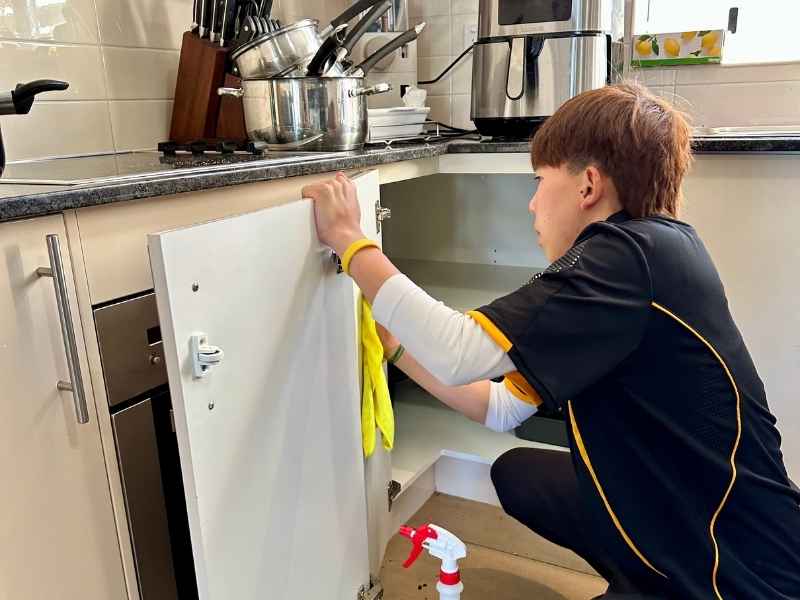
How often to clean: Every 3–4 months
Clean with: Duster or nozzle vacuum attachment
Like the fridge, you’ll need to clean up the cupboards and drawers every few months!
Take everything out of the cupboard or drawer. Toss out any food that’s long expired, spoiled, or mouldy. (Any dented or buckled cans need to go.)
Work one cupboard or drawer at a time so you’re efficient and thorough. Use a soft duster or a handheld vac with a nozzle attachment to hoover up dust and debris.
Use an appropriate cleaner to wipe all the surfaces clean, including the undersides. Fully dry the cupboard or drawer before you put things back. (Except for that jar of food that expired 2 years ago!)
Clean the oven
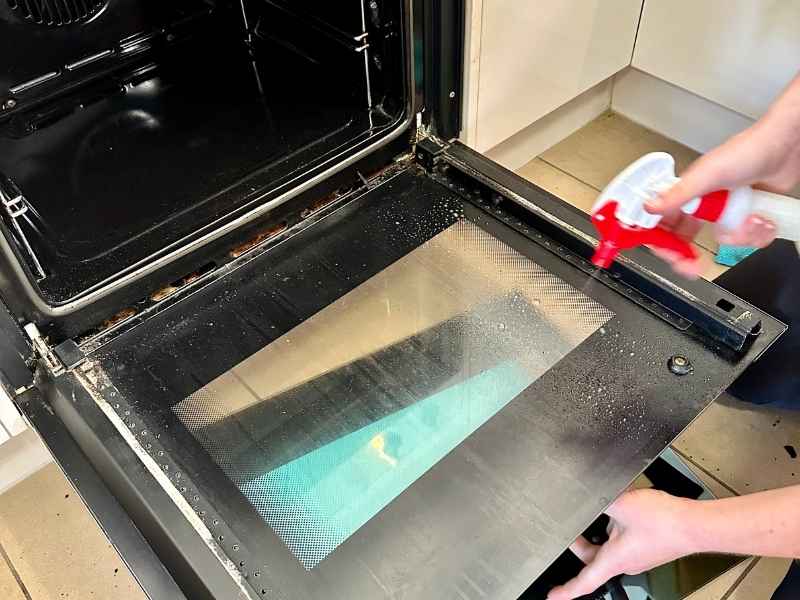
How often to clean: Every 3–6 months
Clean with: Commercial oven cleaner
Light cleaning after every use helps minimise the build-up of grease and grime in your oven! Then you can do a more thorough job every 3 months (or 6 months if you don’t use it much).
To remove burnt-on food or grease, gently heat the oven to 50ºC (122ºF) for a few minutes. That will warm up any debris and make it easier to scrape off.
For deep cleaning the oven, use a good-quality oven cleaner. These products will also clean the glass oven door!
Work with the oven shut off and fully cool. If you’re able, unplug the oven or shut off the gas line as a safety precaution.
Follow the product instructions, and do not mix it with other cleaning solutions. Leave the oven open to air out afterwards.
Make sure to clean the oven racks and trays as well! You can wash them in a hot, soapy solution or use a little oven cleaner.
Clean the rangehood
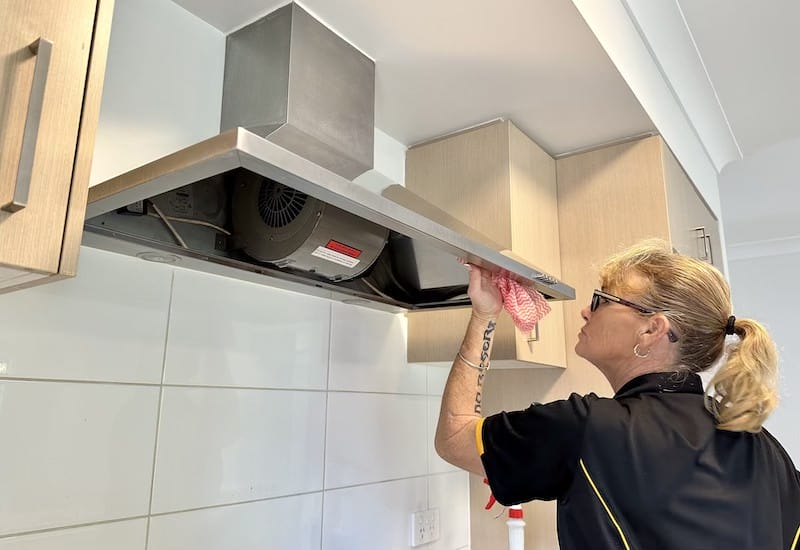
How often to clean: Filter – every 3 months; Rangehood – every 6 months
Clean with: Hot water and dish detergent
Your rangehood plays a key role in keeping your kitchen hygienic. Regular cleaning ensures it works efficiently, maintains air quality, and doesn’t become a fire hazard.
You can clean a rangehood with hot water and anti-grease dish detergent. For stainless steel rangehoods, tackle stubborn grease with Dawn Powerwash.
Avoid spraying cleaner directly onto the rangehood, as you don’t want to get any circuitry or wires wet. Instead, dampen a cloth or sponge with the cleaning solution and use that to scrub the surfaces.
To clean the rangehood filter, wash it in warm, soapy water. Charcoal filters are not washable, though — instead, replace them every 3 months.
Clean the exhaust fan
How often to clean: Every 3–6 months
Clean with: Hot water and dish detergent
Kitchen exhaust fans help vent out hot air and any airborne particles that your rangehood doesn’t filter out. A clean fan ensures a fresh, well-ventilated space.
You can clean the exhaust fan on your own, but call an HVAC specialist to deal with the ductwork!
Use a vacuum with a crevice attachment to suck out dust and debris from the fan and cover. Afterwards, scrub off any dirt with warm, soapy water and a non-abrasive sponge.
Thoroughly dry all the parts before reassembling the exhaust fan.
Tidy up cleaning supplies
After everything, don’t forget to clean your supplies, too! They’ve scrubbed and wiped a lot of dirt, so they deserve some TLC.
Toss any cleaning cloths and sponges into the laundry with a good detergent.
If the cloths and rags feel extra dingy, you can strip wash them with a homemade mix of borax, washing soda, and detergent.
Rinse any brushes used for scrubbing, then disinfect them with a little rubbing alcohol.
Put the cleaning products in their proper storage spaces, where they can sit until the next time you need to scrub and spruce up your kitchen.

